(单词翻译:单击)
The plague has killed hundreds of millions, sweeping across entire countries and bringing civilizations to their knees. Even though we now know more than those who suffered through the biggest outbreak, knowing more about the disease makes it no less frightening.
鼠疫曾杀死上亿人,横扫全世界并使人类文明屈膝。尽管现在我们对这种疾病的了解比那些在鼠疫世界性大流行中死难的古人要更多,但这并不妨碍我们进一步了解它以减轻对它的恐惧。
10、There Are Different Types
鼠疫有不同的类型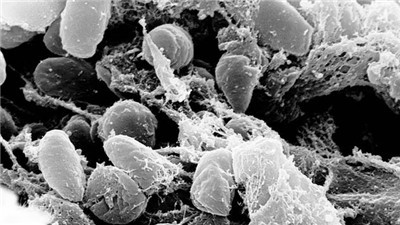
We hear most about the bubonic plague, but that’s actually just one of three plague varieties. The bubonic plague is distinguished by swollen lymph nodes, called “buboes,” which give the disease its name. This type is spread only through the bites of fleas and blood contact with the infected insect; there is no way that bubonic plague can spread from one person to another.
我们都听说过黑死病,其实它只是三种鼠疫之一。黑死病会使得腹股沟淋巴结肿大。这也是它学名(淋巴腺鼠疫)的由来。黑死病只能通过跳蚤和与染病昆虫的血液接触两种方式传播,而不能通过人际传播。
Similarly, septicemic plague is spread only through breaks in the skin and by blood contact. It worsens as bacteria multiply in the blood stream. Septicemic plague has many of the same symptoms as bubonic plague, including fever and chills, but it lacks the bubonic plague’s telltale nodes.
类似的,败血症鼠疫通过皮肤创口和血液接触传播。它的病因是细菌在血液中大量繁殖。败血症鼠疫与黑死病在症状上十分相似,包括发烧和发冷,只是没有它标志性的淋巴结肿大。
The third type is the only one that can transmit from person to person. Pneumonic plague is airborne and can pass from one person (or animal) to another just by breathing in close proximity to someone. The different types of plague can mutate into one another; pneumonic plague and septicemic plague are often complications of untreated bubonic plague.
第三种鼠疫是唯一一种通过人际传播的。肺炎型鼠疫通过空气,仅凭呼吸就可以在人人,人畜,畜畜之间传播,不同的鼠疫通过变异能够相互转化;肺炎型鼠疫和败血症鼠疫往往是黑死病的并发症。
Because the different types have similarly devastating effects, we’ve long thought that bubonic plague was the disease that swept across Europe during the Black Death. New research supported by DNA evidence suggests the Black Death wasn’t bubonic plague after all but the faster-spreading pneumonic plague.
因为不同类型的鼠疫都有相似的严重症状,所以我们很长时间都以为黑死病(淋巴腺鼠疫)是在黑死病时期席卷欧洲的罪魁祸首,但新的研究表明在黑死病时期肆虐的并非淋巴腺鼠疫,而是能够快速传播的肺炎型鼠疫。(注:全文中认为黑死病是起源于中国的,依据是第二次世界鼠疫大流行的发源地是中国云南。这是错误的,因为第一次世界性鼠疫大流行的发生地仅限于东罗马帝国和地中海地区,与中国无关。事实上鼠疫是世界性的疾病,古代长期在全世界范围内流行,不能简单的将其起源归到中国)
9、It Originated In China
它起源于中国
Researchers have successfully traced the presence of bubonic plague back to its origins in China, more than 2,600 years ago.
研究人员成功地将鼠疫的历史追溯到中国--它的起源地,大约2600年前
Different strains of the plague have different bacterial structures. By looking at each strain’s distribution, researchers have traced bubonic plague backward along the Silk Road, isolating 17 different bacterial strains. All these mutations trace back to a single type of bacteria that only started spreading outside of China in the last six centuries, carried by rats on ships leaving Chinese ports.
不同的瘟疫的不同菌株具有不同的细菌结构。通过观察不同的瘟疫,研究者将黑死病追溯丝绸之路上,隔离17种不同的菌株,这些变异种都来源于一种细菌,这种细菌在最近六个世纪里只在中国传播过,通过在中国船上的老鼠传播到世界各地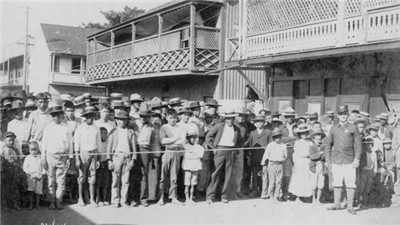
In 1409, ships carried the plague into East Africa. It also spread outward both east and west, through Europe and through Hawaii. It eventually came to the United States in the late 1800s after an epidemic swept through the Yunnan province.
在1409年,这些船带着瘟疫到了东非,同时在西部和东部传播,传播到了欧洲和夏威夷,最终在云南的一次爆发之后在1800年左右传播到了美国
8、The Village That Sacrificed Itself
自我牺牲的村庄
In 1665, a tailor from the village of Eyam in Derbyshire, England ordered cloth from London. When the delivery came, the village received much more than just cloth—it became infected with the plague, which was already laying waste to the capital. People started dying, but they knew the plague hadn’t spread to nearby villages. So, led by clergyman William Mompesson, the villagers decided to quarantine themselves, staying in the plague-stricken town to prevent the disease from spreading.
1665年,一位英格兰德贝郡Eyam村的裁缝向伦敦订购布料。当货物送达时,这个村庄收到的远不止是布料——还有布料所染上的,在首都垃圾堆中蛰伏已久的鼠疫。人们开始死去,但是他们知道这瘟疫并未向邻近村庄传播。所以,在牧师William Mompesson的领导下,村民们决定自我隔离,驻留这被瘟疫击倒的小村庄里以防止其继续向外扩散。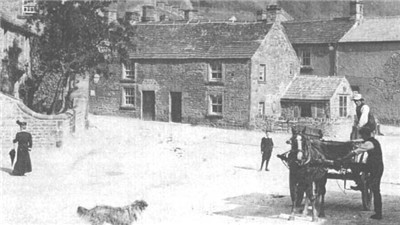
The quarantine began in June 1666. From that point onward, no one could enter or leave the village. Neighboring towns left food at designated places well outside of the village proper. Pre-quarantine, 78 died, and by the end of the plague, that number climbed to 256. Before the townspeople opened their village once again to outsiders, they burned furniture and clothing, hoping to eradicate any traces of the disease that might still lie dormant.
这场隔离行动开始于1666年6月。从那时起,没人可以出入村庄。附近诸村只能将食物留在该村外的指定地点。在隔离前已有78人死亡,在瘟疫结束时,死亡人数攀升至256人。在村民们重新开放村庄与外界接触时,他们烧毁了家具和衣物,希望彻底销毁任何可能残留瘟疫的遗迹。
The sacrifice was a success. None of the neighboring villages had a single case of the plague. Mompesson lost his wife Katherine to the disease, but he himself survived.
这场牺牲成功了。邻近村庄无一人染上鼠疫。Mompesson 牧师在瘟疫中痛失爱妻,但自己侥幸存活。
7、Conspiracy Theorists Used It To Persecute Jews
阴谋家借鼠疫迫害犹太教徒
With the plague decimating Europe during the 14th century, Christians and Jews started playing the blame game. An estimated 25 million people died in the first part of 1348, and a rumor soon began that the plague was a Jewish conspiracy to wipe out Christianity. Supposedly, the conspiracy had begun in Toledo, Spain and spread throughout Europe.
当14世纪鼠疫在欧洲肆虐时,犹太教和基督教开始借此相互攻击。在1348年一次造成2500万人死亡的鼠疫过后,一个传言迅速流传开来,传言说鼠疫是犹太教企图抹杀基督教的阴谋。据推测,该阴谋开始于托莱多,西班牙并且传播到了欧洲。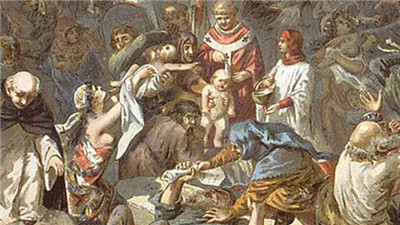
The Count of Savoy started arresting and interrogating Jews, determined to find his version of the truth. His brutal torture elicited many confessions of responsibility, mostly people confessing to poisoning town and city water supplies. The count sent these confessions to other towns as a warning, but the people there took them more seriously. Hundreds of Jewish settlements were burned to the ground, and countless people were murdered.
Savoy
伯爵开始逮捕审讯犹太教徒,决心找出他所谓的“真相”。他残酷的拷问叫许多人认罪,多数都承认在城市和乡村的供水中投毒。伯爵将这些“认罪”作为警告发往其他城镇乡村,但那些地方对此作出了更加激烈的反应。上百的犹太教场所被焚毁,无数教徒被屠杀。
In Strasbourg, nobility and city authorities clashed over whether to massacre their Jewish citizens. The nobles figured doing so could remove the threat of plague and their creditors in one go. On Valentine’s Day 1349, around 2,000 Jews burned on a massive wooden platform in Strasbourg, their wealth seized and redistributed among the Christian nobles.
在斯特拉斯堡,贵族阶级和市政府争论是否应该屠杀他们当地信仰犹太教的市民。贵族们指出这样做可以解除鼠疫的威胁并同时消灭他们的债主。在1349年情人节当天,约2000名基督徒在斯特拉斯堡内的一处大型木质平台上被活活烧死,他们的财产也被当地贵族掠夺瓜分。
The plague still came to Strasbourg. It took 16,000 lives.
但瘟疫依然来到了斯特拉斯堡。它带走了16000条人命。
6、The Plague Wasn't A Guaranteed Killer
鼠疫并非箭无虚发的杀手
Many of us imagine that the plague was a certain death sentence. That belief comes from the massive, widespread devastation the plague caused rather than its effects on individual sufferers. Many stories actually tell of people simply immune to the plague, and others record those who contracted the disease but survived. Marshall Howe was one such individual.
我们很多人都以为鼠疫是一种必死的疾病。这种看法来自于鼠疫造成的大面积严重的破坏而非他对个人造成的伤害。很多故事记载了对鼠疫具有免疫体质的人群,另一些故事则记载了病愈的幸存者。Marshall Howe就是这样一个人。
Howe lived in the village of Eyam during its quarantine, and after recovering from the plague, he helped bury those who died from it. He was reportedly carrying one man to his grave when the corpse spoke and asked for something to eat. The supposed dead man eventually recovered. Another Eyam resident, Margaret Blackwell, recovered from the plague after being so overcome with thirst that she drank a pot of melted bacon fat.
Howe在Eyam村隔离时期正驻留于村中,在他患病并且病愈之后,他帮助掩埋了那些病亡的村民。据说一次在他将尸体往坟墓搬运时,“尸体”开口说话并要吃东西。这个本该死去的人最终病愈并活了下来。另一个Eyam的患病村民Margaret Blackwell,在极度干渴的情况下喝下一大罐融化的猪油,最后病愈了。
Studies of Black Death victims’ skeletal remains reveal a telling tale. Most already suffered from some other ailment, such as disease or malnutrition, before contracting the plague. The plague did kill previously healthy individuals, but it’s now thought that many who were healthy stood a chanceat survival.
对黑死病受害者骸骨的研究揭示了这样一个生动的事实。大部分受难者在感染瘟疫之前承受着其他的苦痛折磨,比如疾病和营养不良。当然,鼠疫确实曾杀死了很多原本完全健康的人,但现在的观点是,很多原本健康的病患并非必死无疑。
5、A Teenage Nostradamus Became A Successful Plague Doctor
一位青年预言家成为一名成功的鼠疫医生
Nostradamus is today largely remembered for his vaguely worded prophecies. But in 1518, he was traveling the French countryside acting as a plague doctor—and he was a mere 15 years old. After living this way for several years, he reenrolled in university (he’d started at 14 but had dropped out to become a traveling apothecary) and earned his degree in medicine in 1522. He continued to work as a plague doctor, as he was seemingly immune to the disease himself. According to his writings, Nostradamus felt he was doing little good in treating the afflicted because his remedies only made victims comfortable rather than curing them. In actuality, he was one of the first doctors to get it right. Instead of typical medieval treatments like leeches and bleeding, Nostradamus pushed for curing the plague with cleanliness. Patients were encouraged to go outside and to get fresh air. He kept those patients and their surroundings clean and disposed properly of infected corpses. He also subscribed to the notion that the plague was caused by bad air, and he developed a spice and rose lozenge that would ease sufferers’ symptoms. At one point, he had such success curing people of the plague that he was comfortably supported by donations from individuals who lived in the city of Provence.
诺查丹玛士现今还被人提及很大程度上是由于他那些措辞模糊的预言,但在1518年,他作为一名瘟疫医生而周游法国乡村——那时他才15岁。在行医几年之后,他重返大学校园(他在14岁时入学但中途辍学成为一名旅行药剂师)并在1522年获得医学学位。之后,他选择继续当一名鼠疫医生,而他似乎对鼠疫具有特殊的免疫力。根据诺查丹玛士的记载,他其实对消除患者的痛苦没做太大贡献。因为他的治疗方法其实不能让他们痊愈,只能让他们好受点。实际上,他是第一个进行正确治疗方法的人。不像中世纪典型的治疗法 ,比如水蛭吸血法和放血法。他坚持要用清洁疗法来治疗瘟疫。他的病人们都被鼓励到外面去呼吸新鲜空气。他还让他的病人和周围的环境保持清洁,同时他也合理的处理受到感染的尸体。他也发表过这样的言论,瘟疫是恶劣的空气传播致病的。并且他还发明了一种香料和玫瑰含片来减轻患者的病症。他有一次居然成功的治愈了患有瘟疫的人,所以普罗旺斯的居民都给他捐款作为报答。
4、It Changed World Culture
改变了世界文明
The plague’s spread left survivors in a world forever changed. It brought a new awareness of death and mortality, and the artists of the time turned to painting what they saw around them. In eras of plague, particularly the 14th and 16th centuries, art got much darker. Religious paintings often featured the dead. Hell was depicted more often than heaven—and oftentimes, it was a hell on Earth.
瘟疫的传播留给幸存者是永远改变了的世界。让人们对死亡和必死命运有了新的理解,因此,这个时期的画家开始绘制他们身边所看到的东西。在瘟疫流行的时代,尤其是14世纪和16世纪期间,艺术的格调也更加黑暗。宗教性质的绘画通常也以死亡为主。地狱比天堂出现的次数还多,通常他们绘制的都是人间地狱。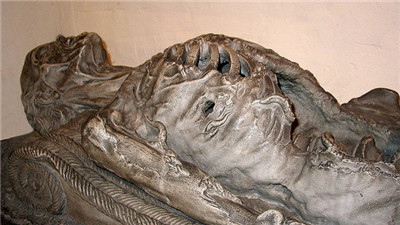
One of the eeriest styles of art to come out of the 16th century was a change in tomb and gravestone design. Before, people were often shown at rest. Now, artists introduced the transi, a form of sculpture that more accurately showed the dead rotting flesh and skeletal form.
16世纪还生成一种非常恐怖的艺术,通常体现在坟墓、墓碑设计的改变上。之前,人们通常以安歇的形式出现。而这时,画家们介绍死亡通常以“转变”为主题来表现,这一类型的壁画更加直观精确的描绘出了尸体的腐烂和骷髅的形成过程。
The plague had another strange effect on the world’s art and literature, and that wasn’t just a change in content but in style and quality. When the plague struck, it attacked without heed to a person’s standing, status, or occupation. Many great masters died in the midst of teaching their proteges. That in turn led to a dynamic shift in the quality and techniques present in art from the time.
瘟疫的还影响世界的艺术与文化,这不仅仅是表现在内容上,还包括了形式和质量上。当瘟疫来临时,不管你处于什么样的立场、地位和职位,都不能幸免。许多伟大的大师都死在给门徒教学的过程中。这反过来又导致了那个时代的艺术在质量上和技术上的转变。
3、The Plague Bacteria Starved Fleas
瘟疫病毒让跳蚤们挨饿
Bubonic plague is spread by fleas, but the whole process is actually a lot more complicated and disturbing than that description suggests.
黑死病(腹股沟淋巴结炎性鼠疫)经由跳蚤们传播,但是整个传播过程实际上要比描述的更加复杂、更加让人恐慌。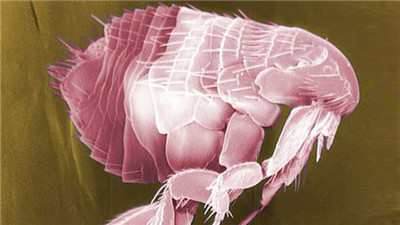
Fleas survive on the blood of animals, and so does the plague bacteria. Once a flea ingests diseased blood, the infection goes to work on the flea itself. It begins to reproduce in the flea’s stomach, living in the digestive tract of the insect and effectively blocking its digestive process. This often kills the flea, but in the meantime, it starves it. This means that the flea bites more often and looks for more animals for nourishment, spreading the disease faster than a flea with a normal life cycle.
跳蚤们靠动物的血液生存,瘟疫病毒也是如此存活。一旦跳蚤吸食了被感染的血液,这只跳蚤便被感染了。病毒在跳蚤的胃里繁殖,继而生存在跳蚤的消化道里。跳蚤的消化过程便被大大滴限制了。通常这样会杀死被感染的跳蚤,在此期间跳蚤会遭受饥饿煎熬。这意味着被感染的跳蚤要寻找和叮咬更多的动物来维持营养,所以它们传播疾病的速度要比正常的跳蚤快很多。
Cats and rats are particularly susceptible to the plague virus, which further helps it spread. When the flea’s usual host—rodents—start dying out in massive amounts, it seeks other hosts, pushing the disease to domesticated animals and humans. (Dogs have a natural resistance to the plague bacteria, and even if they’re bit and are repeatedly exposed, they usually don’t become sick.)
猫和老鼠尤其容易感染到瘟疫病毒,这进一步帮助了病毒的传播。当跳蚤的宿主(啮齿目动物)大量死去,跳蚤便去寻找其他的宿主,于是瘟疫便被传给家养的动物和人类。(狗对瘟疫病毒有一种天然的抵抗力,即使它们经常被跳蚤叮咬,被感染瘟疫病毒,它们也不会生病。)
2、Death-Bringing Plague Ships
带有致命瘟疫的船只
As we mentioned earlier, the plague sometimes traveled from one area to another by ship, and this was actually one the quickest ways in which it spread. In 1347, Italian ships spread the plague from Constantinople to Alexandria to Marseilles and then on to Venice, Genoa, and next on to the rest of Europe.
当我们提到早先瘟疫有是通过船只从一个地方旅行到另一个地方,并且这确实是它传播的最快的方式。在1347年,意大利船只将瘟疫从君士坦丁堡到亚历山大到马赛然后到威尼斯,热那亚然后是到欧洲其他地方。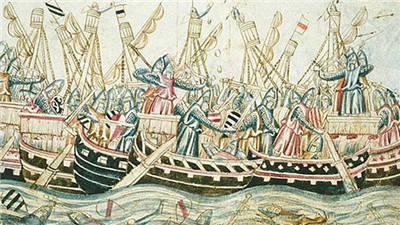
Why didn't the trading ships just stop? Surely captains would weigh the benefits of bringing a plague-stricken crew to land against preventing the spread of the plague throughout the continent?
为什么这些贸易船只不只是停靠呢?肯定的是船长要权衡将瘟疫-是将患病的全体船员带到陆地,还是避免让瘟疫传遍全大陆?
It turns out the plague was much too sneaky to allow such precautions. It would appear on ships well before making itself known. First, it would incubate, multiply, and makes the rounds of the rat population. Then it would jump to humans, and even then, it could take up to five more days to make a person ill. A trading ship could become a death ship for almost a monthbefore anyone on board would have the slightest idea anything was wrong.
然而,瘟疫的传播是如此的悄无声息,这样的预防也是没用的。它在被人们发现之前就会感染船上的人。首先,它会孵化,繁殖并且获得老鼠种群的循环。然后他将跳到人类身上,甚至然后,他将再用五天时间使一个人患病。经过几乎一个月,在船上的人有哪怕一丁点察觉之前,这艘贸易船就被瘟疫变成了一艘死船。
By nature, rats on a ship would largely avoid human contact. In many cases, plague-bearing fleas would find new rat hosts once ships made port or would stow away in cargo that was then taken and distributed throughout the destination city.
自然而然地,船上的老鼠会尽量避免与人类接触。在许多情况下,感染瘟疫的跳蚤在船只靠岸时找到新的老鼠宿主或是偷乘在货物中然后被带到并散布到整个目的城市。
1、Believed Causes Of The Plague
人们所认为的引发瘟疫的原因
The rampant illness and the countless deaths left survivors throughout history looking for a reason for their suffering. One common idea was that mankind brought on the plague by its own evil. Supporters of this theory pointed to passages in the Bible where God used pestilence and plagues as a weapon to punish the unholy.
瘟疫及其造成的无数死亡不禁让幸存者们思考这背后的原因到底是什么。一个普遍的看法是人类因自己的罪恶而引发了瘟疫。相信这种理论的人指向了《圣经》中的某些章节,里面说道上帝将会使用鼠疫和瘟疫来惩罚那些罪恶的人们。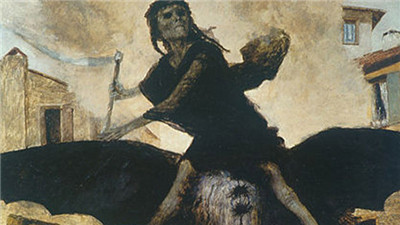
In the Book of Revelation, Pestilence is one of the Four Horsemen of the Apocalypse, and people felt that this disease surely heralded the end of the world. To the nobility and other authority figures, this idea had a practical advantage. Should the masses believe that a higher power was holding them accountable for their actions, said authorities could more easily regulate activities that they thought troublesome, like gambling and brothels.
在《启示录》中,鼠疫是天使四骑士之一,人们觉得这种瘟疫的发生肯定意味着世界末日的来临。对于贵族和其他当权者来说,这样的理论是很有用的。如果大众认为存在着一个更高的力量在审视他们的所作所为,那么当局者在管理上就会轻松得多,比如在赌博和妓院这样的事情上。
Ideas about cures for the plague were linked to possible causes. It was long thought that the balance of the humors and states of the body was crucial to staying healthy; if that was true for humans, then the same might be true for the universe. This led to a number of astrological theories on what was causing the clear imbalance of life and death on Earth.
要想解决瘟疫,就得找到引发瘟疫的原因。长久以来人们都认为心情与身体状态的平衡是保持健康的关键;如果这种理论也适用于人类的话,那么也可能同样适用于宇宙。所以在何物引发地球上生命与死亡失衡的问题上,出现了很多占卜理论。
Quoting Greek philosophers and their writings on the balance of life, astrologer Geoffrey de Meaux tried to use the positioning of the planets within the zodiac to determine how long each outbreak would last, why certain cities were vulnerable, and who would die next.
在援引了希腊哲学家们及其有关生命平衡的作品的情况下,占星家Geoffrey de Meaux 试图利用十二宫图里的行星位置来预测每一次的瘟疫爆发会持续多久,为什么某些城市会变得如此脆弱以及下一个死去的将是何人等。


